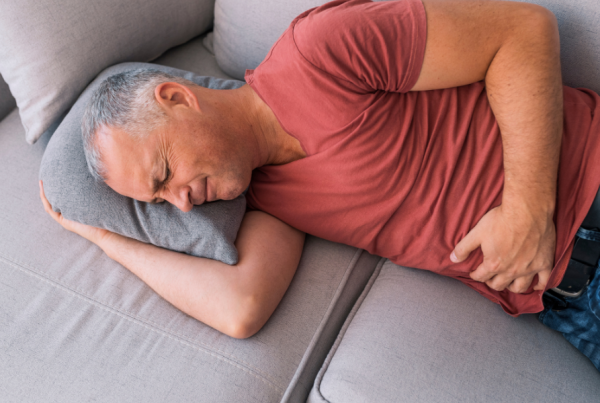Arousal Dysfunction
Move Better. Live Fuller. Your Wellness Journey Starts Here.
Schedule a FREE Discovery Call!
What Is Arousal Dysfunction?
Arousal dysfunction, also referred to as “sexual interest disorder” or “sexual arousal disorder,” is a condition characterized by the lack of or low sexual arousal in response to stimulation. Individuals with this condition may struggle to become aroused or stay aroused even with sexual stimulation.
This condition can be categorized in three ways:
- Genital: A lack of a physical sexual arousal response (swelling, sensation, erection, or lubrication).
- Non-genital: A lack of a psychological arousal response (the interest in having sex or sexual acts).
- Combined: A lack of both psychological and genital arousal.

It is important to note that this condition is only considered a disorder if the individual wishes to become aroused or experiences distress from the lack of arousal responses. For individuals who do feel distress from a lack of arousal, other symptoms can include:
- Lack of orgasms
- Pain during sex
- Difficulty maintaining arousal during sex
This condition is very common, especially for individuals who have a vagina. It can occur at any point in a person’s life, even if they have not experienced trouble with arousal before. Arousal dysfunction may be something a person experiences all the time, such as every time they try sex—or it may only happen occasionally.
What Causes Arousal Dysfunction?
Arousal dysfunction can stem from a combination of physical and psychological factors, such as the examples described below:
Psychological Factors
Psychological aspects such as stress or anxiety can play a large role in arousal dysfunction. These emotions can create an activated nervous system and tension in the pelvic floor, both of which can contribute to the lack of relaxation or blood flow needed for an arousal response. Psychological factors may be created by:
- Previous negative sexual experiences or trauma
- Anxiety, guilt, or shame from cultural or religious beliefs relating to sex
- Relationship struggles
- Performance anxiety
- Body image or confidence
Physical Factors
Physical factors that affect arousal can include many aspects, including any of the following (which we will discuss in detail separately):
- Pelvic floor dysfunction
- Neurological causes
- Underlying conditions, surgery, or injury
- Hormonal changes
- Physical comfort
Pelvic Floor Dysfunction
The pelvic floor is very important for sexual arousal. It directly affects physical (genital) arousal, and indirectly affects non-genital arousal. The pelvic floor is an important group of muscles that everyone has, regardless of their genitals.
It plays a huge role in sexual function, sensation, and appreciation. For example, the pelvic floor controls or affects aspects like arousal, sensation, erection, orgasm, ejaculation, and more.
The pelvic floor is able to provide most of its sexual functions through contraction and relaxation. When these muscles are too tight, weak, inflexible, or poorly coordinated, they cannot perform their jobs properly—known as pelvic floor dysfunction. Pelvic floor dysfunction can restrict blood flow, irritate important nerves, and affect physical comfort during sex. All of these aspects caused by pelvic floor dysfunction can have negative effects on arousal:
- Overactive, tight pelvic floor muscles can restrict the blood flow needed for a genital arousal response. They may compress important nerves that help provide sensation or contribute to arousal signals. Tight muscles can also cause pelvic pain or pain during sex.
- Weak pelvic floor muscles may disrupt blood flow, lessen sexual sensation, and contribute to a lack of orgasms. Weak pelvic floor muscles can contribute to other dysfunctions such as erectile dysfunction, which may contribute to low arousal.
- A lack of pelvic floor muscle coordination can affect sexual responses, disrupting orgasm and contributing to painful sex.
Neurological Causes
The nervous system plays a role in sexual arousal, too. Nerves allow for physical sensation as well as arousal signals from the brain; when these nerves are compressed or irritated, those arousal signals may become impaired. Additionally, individuals with high levels of stress or who have conditions that cause pelvic pain may have a more sensitive nervous system, which can make achieving arousal more difficult.
Underlying Conditions, Surgery, or Injury
Pre-existing or underlying conditions can contribute to arousal, including conditions such as diabetes, cardiovascular disease, or any disorder affecting the nervous system or circulatory system. These conditions impact the body’s natural ability to encourage arousal responses, and the medications associated with these conditions can contribute to low arousal.
Similarly, past injuries or surgeries can affect pelvic health, nerve health, muscle tension, and blood flow, which may lead to issues with arousal.
Hormonal Changes
Hormonal changes resulting from menopause, birth control, breastfeeding, pregnancy, or postpartum can reduce sexual arousal. Hormonal changes, especially those involving estrogen, can not only affect arousal but also comfort during sex. This is due to the thinning and dryness of vaginal tissues—which unfortunately can worsen the individual’s sexual experience and psychological response to sex.
Changes in the hormone testosterone can affect an individual’s libido and sexual desire, which in turn can reduce arousal responses, too. Lower testosterone can contribute to conditions such as erectile dysfunction, which in turn may affect your psychological and physical arousal.
Physical Comfort
In many cases, individuals may not be meeting certain aspects of sexual needs adequately, which can strongly affect sexual comfort. Low sexual comfort can lower sexual satisfaction and interest, and create a negative association with sex. Some examples of things that affect sexual comfort include:
- Lubrication: Inadequate lubrication or using the wrong type of lubricant for your needs can greatly impact sexual comfort, leading to pain, irritation, or discomfort during sexual activities.
- Stimulation: Not receiving a proper amount of stimulation to start arousal can affect sexual comfort—in other words, trying sexual activities before an individual is properly aroused. Stimulation can vary from person to person, but without the genital responses of lubrication, swelling, and increased blood flow, sexual comfort is often lower.
- Irritants: Utilizing certain sexual aids, such as some condoms or lubricants, may cause irritation or dryness. For example, some individuals have allergies to latex (latex condoms) or may have reactions to certain lubricants. Be sure to choose non-irritating lubricants and condoms that work best for you and your partner(s).
Physical Therapy for Arousal Dysfunction
Pelvic floor physical therapy for arousal dysfunction aims to restore sexual function, comfort, sensation, and arousal by solving pelvic floor dysfunction. Reducing pelvic floor tension and improving strength will allow for better blood flow, reduced nerve irritation, and the pelvic floor functions necessary to support genital arousal!
To begin, your pelvic floor physical therapist will perform an evaluation by discussing your symptoms and any medical history that may impact your sexual health. With your consent, they may conduct internal or external examinations to better understand the health of your pelvic floor and surrounding structures. The physical therapists at Hive Therapy and Wellness are highly trained and experienced with examinations; however, we understand that some individuals may have different comfort levels in those aspects.
At Hive Therapy and Wellness, we will always request consent before any examination or treatment. You are never required to give consent to any exam or treatment that you are uncomfortable with. Internal examinations may provide very useful information for your plan of care, but Hive will always work with your comfort level—so don’t avoid treatment for fear of internal examination or treatment!
Once your evaluation is completed, your pelvic floor therapist will create a unique plan of care for your needs. This care plan will include a variety of treatment methods, many of which have been outlined below.
To Reduce Tension and Improve Comfort
There are many treatments that can be utilized to reduce tension in the pelvic floor. Relieving this tension will improve sexual comfort, encourage the blood flow needed for arousal, and allow for better sexual function.
One common treatment used to relieve tension and trigger points is manual therapy. This treatment involves hands-on methods utilizing hands or tools to manipulate and mobilize tight muscle tissue or irritated nerves.
This treatment may be done internally via the vagina or rectum by utilizing tools such as a pelvic wand to address the pelvic floor muscles. Manual therapy may be performed externally to muscles of the hips, back, abdominals, and pelvis—as these areas can contribute to pelvic floor muscle tension.
Other methods used to relieve tension may include:
- Spinal manipulation or joint mobilization to address any misalignment that could be contributing to pelvic tension.
- Practicing and learning relaxation techniques that help calm your mind and actively relax the pelvic floor.
- Incorporating lifestyle changes and behavioral modifications to reduce muscle tension build-up—often caused by poor posture, harmful restroom habits, and more.
- Practicing desensitization techniques that focus less on sexual performance and more on sensation. Some individuals may benefit from dilator practice if their arousal dysfunction is accompanied by painful sex or vaginismus.
To Improve Function and Coordination
In addition to relieving pelvic floor tension, it will be important to relearn how to control your pelvic floor and strengthen those muscles so that they can better perform their necessary functions. The pelvic floor functions through a series of voluntary and involuntary contractions and relaxations.
To regain control of your pelvic floor’s voluntary movements, your pelvic floor therapists will utilize treatments such as neuromuscular re-education and biofeedback. These treatments will allow you to feel your pelvic floor and practice controlling it, while receiving feedback in real time. This practice will increase your awareness and coordination of these important muscles.
Additionally, they may incorporate other pelvic floor exercises or training methods to improve the strength and flexibility of your pelvic floor! These exercises will likely be accompanied by a full-body exercise routine, to encourage better overall health and address any muscle imbalances that could lead to pelvic floor tension. This routine will include stretching techniques that will improve the flexibility of your pelvis and pelvic floor.
Lastly, your pelvic floor therapist will provide you with important education on at-home care, practice, and more. They can help you better understand your anatomy and how arousal works in the body, as well as why you may be experiencing symptoms like pain or discomfort. They can also teach you about pain neuroscience and how your comfort levels or pain can be affected by the nervous system!
Understanding these concepts can reduce stress or anxiety associated with your symptoms. Our physical therapists are very open to collaboration with your other health professionals, such as sex therapists or mental health professionals, in order to provide you with a more holistic treatment experience!
While in our care, you may experience a variety of treatments—all of which will be especially chosen for your unique needs. However, you can expect any of the following methods to be included in your comprehensive care plan:
- Neuromuscular re-education
- Manual therapy
- Exercise prescription
- Dry needling
- Cupping
- Tissue scraping
- Behavioral modifications
- Therapeutic activities
- Electrical muscle stimulation
- Spinal manipulation
- Therapeutic modalities
- Biofeedback
Arousal dysfunction, also referred to as “sexual interest disorder” or “sexual arousal disorder,” is a condition characterized by the lack of or low sexual arousal in response to stimulation.
Individuals with this condition may struggle to become aroused or stay aroused even with sexual stimulation.
This condition can be categorized in three ways:
- Genital: A lack of a physical sexual arousal response (swelling, sensation, erection, or lubrication).
- Non-genital: A lack of a psychological arousal response (the interest in having sex or sexual acts).
- Combined: A lack of both psychological and genital arousal.
It is important to note that this condition is only considered a disorder if the individual wishes to become aroused or experiences distress from the lack of arousal responses.
For individuals who do feel distress from a lack of arousal, other symptoms can include:
- Lack of orgasms
- Pain during sex
- Difficulty maintaining arousal during sex
This condition is very common, especially for individuals who have a vagina. It can occur at any point in a person’s life, even if they have not experienced trouble with arousal before.
Arousal dysfunction may be something a person experiences all the time, such as every time they try sex—or it may only happen occasionally.
Arousal dysfunction can stem from a combination of physical and psychological factors, such as the examples described below:
Psychological Factors
Psychological aspects such as stress or anxiety can play a large role in arousal dysfunction.
These emotions can create an activated nervous system and tension in the pelvic floor, both of which can contribute to the lack of relaxation or blood flow needed for an arousal response. Psychological factors may be created by:
- Previous negative sexual experiences or trauma
- Anxiety, guilt, or shame from cultural or religious beliefs relating to sex
- Relationship struggles
- Performance anxiety
- Body image or confidence
Physical Factors
Physical factors that affect arousal can include many aspects, including any of the following (which we will discuss in detail separately):
- Pelvic floor dysfunction
- Neurological causes
- Underlying conditions, surgery, or injury
- Hormonal changes
- Physical comfort
Pelvic Floor Dysfunction
The pelvic floor is very important for sexual arousal. It directly affects physical (genital) arousal, and indirectly affects non-genital arousal. The pelvic floor is an important group of muscles that everyone has, regardless of their genitals.
It plays a huge role in sexual function, sensation, and appreciation. For example, the pelvic floor controls or affects aspects like arousal, sensation, erection, orgasm, ejaculation, and more.
The pelvic floor is able to provide most of its sexual functions through contraction and relaxation. When these muscles are too tight, weak, inflexible, or poorly coordinated, they cannot perform their jobs properly—known as pelvic floor dysfunction.
Pelvic floor dysfunction can restrict blood flow, irritate important nerves, and affect physical comfort during sex. All of these aspects caused by pelvic floor dysfunction can have negative effects on arousal:
- Overactive, tight pelvic floor muscles can restrict the blood flow needed for a genital arousal response. They may compress important nerves that help provide sensation or contribute to arousal signals. Tight muscles can also cause pelvic pain or pain during sex.
- Weak pelvic floor muscles may disrupt blood flow, lessen sexual sensation, and contribute to a lack of orgasms. Weak pelvic floor muscles can contribute to other dysfunctions such as erectile dysfunction, which may contribute to low arousal.
- A lack of pelvic floor muscle coordination can affect sexual responses, disrupting orgasm and contributing to painful sex.
Neurological Causes
The nervous system plays a role in sexual arousal, too. Nerves allow for physical sensation as well as arousal signals from the brain; when these nerves are compressed or irritated, those arousal signals may become impaired.
Additionally, individuals with high levels of stress or who have conditions that cause pelvic pain may have a more sensitive nervous system, which can make achieving arousal more difficult.
Underlying Conditions, Surgery, or Injury
Pre-existing or underlying conditions can contribute to arousal, including conditions such as diabetes, cardiovascular disease, or any disorder affecting the nervous system or circulatory system.
These conditions impact the body’s natural ability to encourage arousal responses, and the medications associated with these conditions can contribute to low arousal.
Similarly, past injuries or surgeries can affect pelvic health, nerve health, muscle tension, and blood flow, which may lead to issues with arousal.
Hormonal Changes
Hormonal changes resulting from menopause, birth control, breastfeeding, pregnancy, or postpartum can reduce sexual arousal. Hormonal changes, especially those involving estrogen, can not only affect arousal but also comfort during sex.
This is due to the thinning and dryness of vaginal tissues—which unfortunately can worsen the individual’s sexual experience and psychological response to sex.
Changes in the hormone testosterone can affect an individual’s libido and sexual desire, which in turn can reduce arousal responses, too.
Lower testosterone can contribute to conditions such as erectile dysfunction, which in turn may affect your psychological and physical arousal.
Physical Comfort
In many cases, individuals may not be meeting certain aspects of sexual needs adequately, which can strongly affect sexual comfort.
Low sexual comfort can lower sexual satisfaction and interest, and create a negative association with sex. Some examples of things that affect sexual comfort include:
- Lubrication: Inadequate lubrication or using the wrong type of lubricant for your needs can greatly impact sexual comfort, leading to pain, irritation, or discomfort during sexual activities.
- Stimulation: Not receiving a proper amount of stimulation to start arousal can affect sexual comfort—in other words, trying sexual activities before an individual is properly aroused. Stimulation can vary from person to person, but without the genital responses of lubrication, swelling, and increased blood flow, sexual comfort is often lower.
- Irritants: Utilizing certain sexual aids, such as some condoms or lubricants, may cause irritation or dryness. For example, some individuals have allergies to latex (latex condoms) or may have reactions to certain lubricants. Be sure to choose non-irritating lubricants and condoms that work best for you and your partner(s).
Pelvic floor physical therapy for arousal dysfunction aims to restore sexual function, comfort, sensation, and arousal by solving pelvic floor dysfunction.
Reducing pelvic floor tension and improving strength will allow for better blood flow, reduced nerve irritation, and the pelvic floor functions necessary to support genital arousal!
To begin, your pelvic floor physical therapist will perform an evaluation by discussing your symptoms and any medical history that may impact your sexual health.
With your consent, they may conduct internal or external examinations to better understand the health of your pelvic floor and surrounding structures.
The physical therapists at Hive Therapy and Wellness are highly trained and experienced with examinations; however, we understand that some individuals may have different comfort levels in those aspects.
At Hive Therapy and Wellness, we will always request consent before any examination or treatment. You are never required to give consent to any exam or treatment that you are uncomfortable with.
Internal examinations may provide very useful information for your plan of care, but Hive will always work with your comfort level—so don’t avoid treatment for fear of internal examination or treatment!
Once your evaluation is completed, your pelvic floor therapist will create a unique plan of care for your needs. This care plan will include a variety of treatment methods, many of which have been outlined below.
To Reduce Tension and Improve Comfort
There are many treatments that can be utilized to reduce tension in the pelvic floor. Relieving this tension will improve sexual comfort, encourage the blood flow needed for arousal, and allow for better sexual function.
One common treatment used to relieve tension and trigger points is manual therapy. This treatment involves hands-on methods utilizing hands or tools to manipulate and mobilize tight muscle tissue or irritated nerves.
This treatment may be done internally via the vagina or rectum by utilizing tools such as a pelvic wand to address the pelvic floor muscles.
Manual therapy may be performed externally to muscles of the hips, back, abdominals, and pelvis—as these areas can contribute to pelvic floor muscle tension.
Other methods used to relieve tension may include:
- Spinal manipulation or joint mobilization to address any misalignment that could be contributing to pelvic tension.
- Practicing and learning relaxation techniques that help calm your mind and actively relax the pelvic floor.
- Incorporating lifestyle changes and behavioral modifications to reduce muscle tension build-up—often caused by poor posture, harmful restroom habits, and more.
- Practicing desensitization techniques that focus less on sexual performance and more on sensation. Some individuals may benefit from dilator practice if their arousal dysfunction is accompanied by painful sex or vaginismus.
To Improve Function and Coordination
In addition to relieving pelvic floor tension, it will be important to relearn how to control your pelvic floor and strengthen those muscles so that they can better perform their necessary functions.
The pelvic floor functions through a series of voluntary and involuntary contractions and relaxations.
To regain control of your pelvic floor’s voluntary movements, your pelvic floor therapists will utilize treatments such as neuromuscular re-education and biofeedback.
These treatments will allow you to feel your pelvic floor and practice controlling it, while receiving feedback in real time. This practice will increase your awareness and coordination of these important muscles.
Additionally, they may incorporate other pelvic floor exercises or training methods to improve the strength and flexibility of your pelvic floor!
These exercises will likely be accompanied by a full-body exercise routine, to encourage better overall health and address any muscle imbalances that could lead to pelvic floor tension.
This routine will include stretching techniques that will improve the flexibility of your pelvis and pelvic floor.
Lastly, your pelvic floor therapist will provide you with important education on at-home care, practice, and more. They can help you better understand your anatomy and how arousal works in the body, as well as why you may be experiencing symptoms like pain or discomfort.
They can also teach you about pain neuroscience and how your comfort levels or pain can be affected by the nervous system!
Understanding these concepts can reduce stress or anxiety associated with your symptoms. Our physical therapists are very open to collaboration with your other health professionals, such as sex therapists or mental health professionals, in order to provide you with a more holistic treatment experience!
While in our care, you may experience a variety of treatments—all of which will be especially chosen for your unique needs. However, you can expect any of the following methods to be included in your comprehensive care plan:
- Neuromuscular re-education
- Manual therapy
- Exercise prescription
- Dry needling
- Cupping
- Tissue scraping
- Behavioral modifications
- Therapeutic activities
- Electrical muscle stimulation
- Spinal manipulation
- Therapeutic modalities
- Biofeedback
You can learn more about these treatments on our Treatments Page.





